chapter 6 国际贸易支付
- 格式:ppt
- 大小:734.50 KB
- 文档页数:56
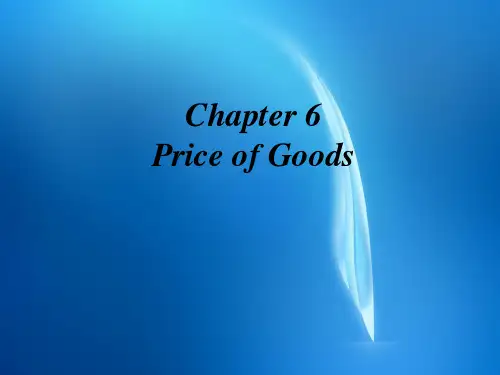
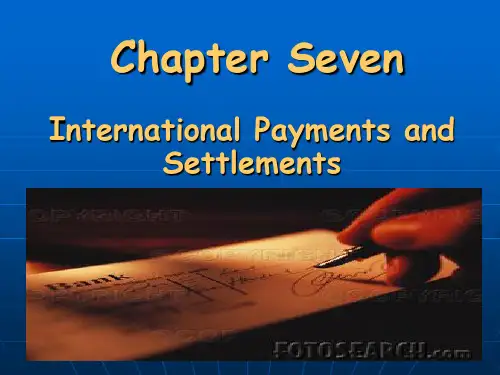


国际贸易实务笔记Chapter 1Introduction to International TradeKey words:Nation boder:过境FID:Foreign Direct investmentCustoms frontier:关境直接投资:Drect investment出口退税:export tax rebates 流动性过剩:excess liquidity东道国:host country 自给自足:self-suffucient经济资源:economic resources 商品交换;exchange of goods资金:capital 以物换物:barter出口拉动型经济增长:export-driven economic growth国际收支顺差:A favorable balance of payment逆差:An unfavorable balance of paymentMeans more money is flowing into a country than flowing out.贸易差额:balance of trade贸易顺差:trade surplus or A favorable balance of trade贸易逆差:trade deficit or A unfavorable balance of trade有/无形贸易:visible or invisible trade货物or 服务贸易:trade in goods or service国际贸易:international trade used by WTOWorld trade对外贸易:foreign trade 海外贸易:overseas trade国际发展委员会:national development and reform commission (NDRC)国际货币基金组织:international monetary fund (IMF)External demand:国外需求trade frictions: 贸易摩擦In the fore seeable future:短期内innovation of style:创新Shift orders:减少订单inquiry offer:询盘B/L;提单Offer:报盘 a fun set of documents:一套单据Firm offer:实盘sign a sales contract :签订销售合同Counter offer :还盘月/日/年(美)日/月/年(英)最好用英式表达Accept counter partner :交易对手Destination of International Trade:The business of buying and selling commodities beyond national borders走私:以任何行为逃避海关监管的行为。
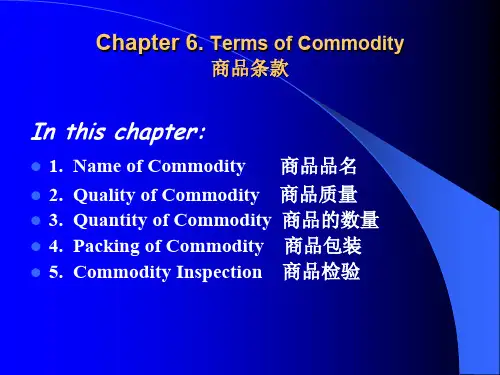
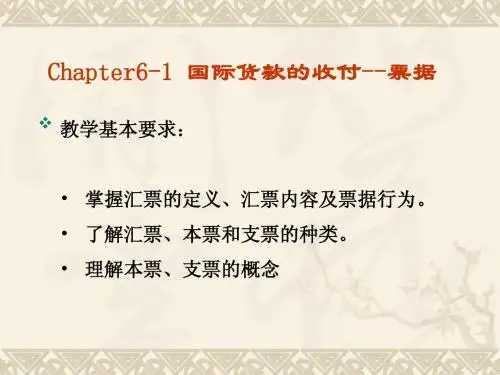
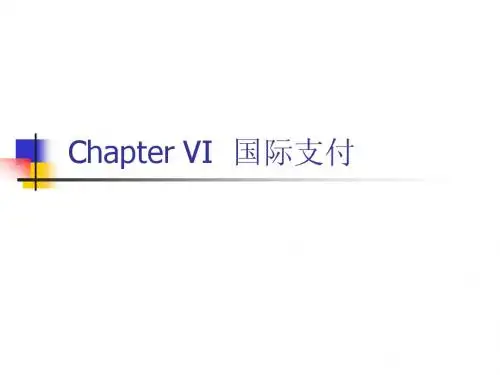
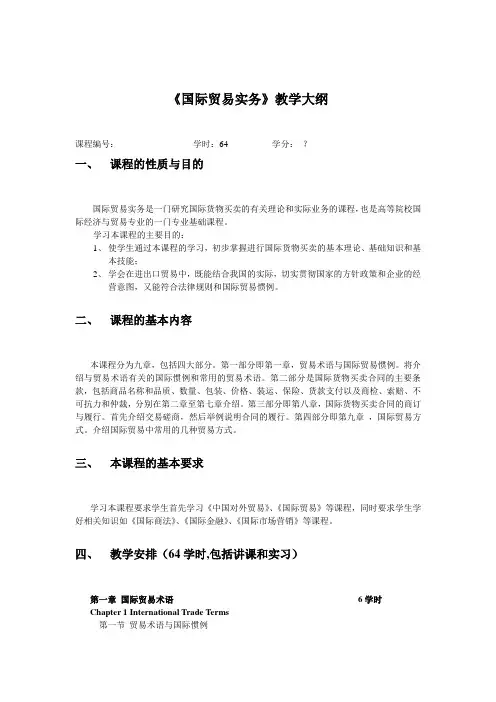
《国际贸易实务》教学大纲课程编号:学时:64 学分:?一、课程的性质与目的国际贸易实务是一门研究国际货物买卖的有关理论和实际业务的课程,也是高等院校国际经济与贸易专业的一门专业基础课程。
学习本课程的主要目的:1、使学生通过本课程的学习,初步掌握进行国际货物买卖的基本理论、基础知识和基本技能;2、学会在进出口贸易中,既能结合我国的实际,切实贯彻国家的方针政策和企业的经营意图,又能符合法律规则和国际贸易惯例。
二、课程的基本内容本课程分为九章,包括四大部分。
第一部分即第一章,贸易术语与国际贸易惯例。
将介绍与贸易术语有关的国际惯例和常用的贸易术语。
第二部分是国际货物买卖合同的主要条款,包括商品名称和品质、数量、包装、价格、装运、保险、货款支付以及商检、索赔、不可抗力和仲裁,分别在第二章至第七章介绍。
第三部分即第八章,国际货物买卖合同的商订与履行。
首先介绍交易磋商,然后举例说明合同的履行。
第四部分即第九章,国际贸易方式。
介绍国际贸易中常用的几种贸易方式。
三、本课程的基本要求学习本课程要求学生首先学习《中国对外贸易》、《国际贸易》等课程,同时要求学生学好相关知识如《国际商法》、《国际金融》、《国际市场营销》等课程。
四、教学安排(64学时,包括讲课和实习)第一章国际贸易术语6学时Chapter 1 International T rade T erms第一节贸易术语与国际惯例1.1 Trade Terms and International Rules第二节常用的三种贸易术语1.2 Three Most Popular Trade Terms第三节货交承运人的三种贸易术语1.3 Three Trade Terms on Delivering to Carrier第四节其他贸易术语1.4 Other Trade Terms第五节贸易术语的选用1.5 Selecting of Trade Terms第二章商品的名称及其质量、数量与包装4学时Chapter 2 Name and Quality of Commodity, Quantity and Packaging第一节商品的名称及其质量2.1 Name and Quality of Commodity第二节数量2.2 Quantity第三节包装2.3 Packaging第三章国际货物运输10学时Chapter 3 International Cargo T ransport第一节运输方式3.1 Transport Modes第二节装运条款3.2 Shipment Clause第三节运输单据3.3 Shipping Documents第四章国际货物运输保险6学时Chapter 4 Insurance of International Cargo T ransportation第一节概述4.1 An Overview of Insurance of International Cargo Transportation第二节海运货物保险承保的范围4.2 Insured Range in Ocean Transportation第三节我国海运货物保险的险别4.3 Ocean Marine Cargo Clause of CIC第四节伦敦保险协会海运货物保险条款4.4 Institute Cargo Clause (ICC)第五节我国陆运、空运货物与邮包运输保险4.5 Overland Transportation Cargo, Air Transportation Cargo and Parcel PostInsurance Clause第六节买卖合同中的保险条款4.6 Insurance Clauses of the contract第五章进出口商品的价格8学时Chapter 5 Price第一节定价时应考虑的问题5.1 Points considered in pricing第二节计价货币和支付货币的选择5.2 Choice of currency for account and payment第三节佣金与折扣5.3 Commission and Discounts第四节合同中的价格条款5.4 Clauses of Price第六章国际货款的收付14学时Chapter 6 International T rade Payment第一节支付工具6.1 Instruments of Payment第二节汇付与托收6.2 Remittance and Collection第三节信用证付款6.3 Letter of Credit第四节银行保函6.6 Banker’s Letter of Guarantee第五节合同中的支付条款6.5 Terms of Payment in Contract第七章检验、索赔、不可抗力与仲裁4学时Chapter 7 Inspection, Claim, Force Majeure and Arbitration第一节检验7.1 Inspection第二节索赔7.2 Claim第三节不可抗力7.3 Force Majeure第四节仲裁7.4 Arbitration第八章合同的商订与履行8学时Chapter 8 T rade Negotiation and Contract Performing第一节合同的商订8.1 Trade Negotiation第二节合同的履行8.2 Contract Performing第九章国际贸易方式4学时Chapter 9 International T rade Modes第一节经销与代理9.1 Distributorship and Agency第二节寄售与展卖9.2 Consignment, Fairs and Sales第三节招标投标与拍卖9.3 Invitation to tenders, Submission of tenders and Auction第四节期货交易与套期保值9.4 Futures Trading and Hedging第五节对销贸易9.5 Counter Trade第六节加工贸易9.6 Improvement Trade第七节电子商务9.7 Commercial Business五、教材和参考资料教材:《国际贸易实务》对外经济贸易大学出版社,黎孝先主编《International Trade Theory and Practice》对外经济贸易大学出版社,张素芳编著参考书:1、吴百福主编.《进出口贸易实务教程》.上海人民出版社2003年版2、《对外贸易实务》中国对外经济贸易教育协会主办(月刊)3、《中国海关》中国海关出版社主办(月刊)4、商务部、海关等相关网站5、杨玲等.《国际贸易与国际金融》.武汉大学出版社《国际贸易实务》课程简介课程编号:课程名称:国际贸易实务英文名称:International Trade Practice学时:50 学分:2.5课程简介:国际贸易实务是一门研究国际货物买卖的有关理论和实际业务的课程,也是高等院校国际经济与贸易专业的一门专业基础课程。
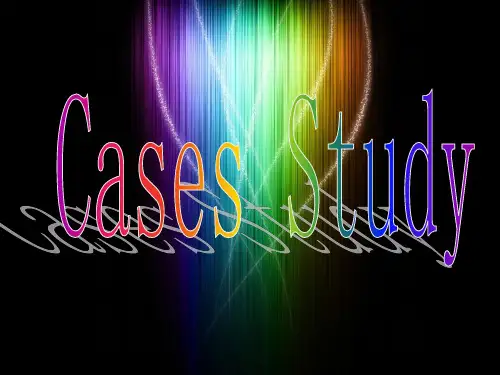

作者、书名、出版社、出版年份、目录Thomas A.Pugel. International Economics(15th). Renmin University of China p ress. 2012-12CONTENTSChapter 1 International Economics Is DifferentFour ControversiesEconomics and the Nation-StateThe Scheme of This BookPART ONE THE THEORY OF INTERNATIONAL TRADEChapter 2 The Basic Theory Using Demand and SupplyFour Questions about TradeA Look AheadDemand and SupplyCase Study Trade Is ImportantGlobal Crisis The Trade Mini-Collapse of 2009Two National Markets and the Opening of TradeChapter 3 Why Everybody Trades: Comparative Advantage 33Adam Smith’s Theory of Absolute AdvantageCase Study Mercantilism: Older Than Smith—and Alive TodayRicardo’s Theory of Comparative AdvantageRicardo’s Constant Costs and the Producti on-Possibility CurveFocus on Labor Absolute Advantage Does MatterExtension What If Trade Doesn’t Balance?Chapter 4 Trade: Factor Availability and Factor Proportions Are KeyProduction with Increasing Marginal CostsCommunity Indifference CurvesProduction and Consumption TogetherFocus on China The Opening of Trade and China’s Shift Out of AgricultureThe Gains from TradeTrade Affects Production and ConsumptionWhat Determines the Trade Pattern?The Heckscher–Ohlin (H–O) TheoryChapter 5 Who Gains and Who Loses from Trade?Who Gains and Who Loses within a CountryThree Implications of the H–O TheoryExtension A Factor-Ratio ParadoxDoes Heckscher–Ohlin Explain Actual Trade Patterns?Case Study The Leontief ParadoxWhat Are the Export-Oriented and Import-Competing Factors?Focus on China China’s Exports and ImportsDo Factor Prices Equalize Internationally?Focus on Labor U.S. Jobs and Foreign Trade 86Chapter 6 Scale Economies, Imperfect Competition, and TradeScale EconomiesIntra-Industry TradeMonopolistic Competition and TradeExtension The Individual Firm in MonopolisticOligopoly and TradeExtension The Gravity Model of TradeChapter 7 Growth and TradeBalanced versus Biased GrowthGrowth in Only One FactorChanges in the Country’s Willingness to TradeCase Study The Dutch Disease and DeindustrializationEffects on the Country’s Terms of TradeTechnology and TradeFocus on Labor Trade, Technology, and U.S. WagesPART TWO TRADE POLICYChapter 8 Analysis of a TariffGlobal Governance WTO and GATT: Tariff SuccessA Preview of ConclusionsThe Effect of a Tariff on Domestic ProducersThe Effect of a Tariff on Domestic ConsumersThe Tariff as Government RevenueThe Net National Loss from a TariffExtension The Effective Rate of ProtectionCase Study They Tax Exports, TooThe Terms-of-Trade Effect and a Nationally Optimal TariffChapter 9 Nontariff Barriers to ImportsTypes of Nontariff Barriers to ImportsThe Import QuotaGlobal Governance The WTO: Beyond TariffsGlobal Crisis Dodging ProtectionismExtension A Domestic Monopoly Prefers a QuotaVoluntary Export Restraints (VERs)Other Nontariff BarriersCase Study VERs: Two ExamplesCase Study Carrots Are Fruit, Snails Are Fish, and X-Men Are Not HumansHow Big Are the Costs of Protection?International Trade DisputesFocus on China China’s First Decade in the WTOChapter 10 Arguments for and against ProtectionThe Ideal World of First BestThe Realistic World of Second BestPromoting Domestic Production or EmploymentThe Infant Industry ArgumentFocus on Labor How Much Does It Cost to Protect a Job?The Dying Industry Argument and Adjustment AssistanceThe Developing Government (Public Revenue) ArgumentOther Arguments for Protection: Non=economic ObjectivesThe Politics of Protection The Basic Elements of the Political-Economic Analysis Case Study How Sweet It Is (or Isn’t)Chapter 11 Pushing ExportsDumpingReacting to Dumping: What Should a Dumpee Think?Actual Antidumping Policies: What Is Unfair?Case Study Antidumping in ActionProposals for ReformExport SubsidiesWTO Rules on SubsidiesShould the Importing Country Impose Countervailing Duties?Case Study Agriculture Is AmazingStrategic Export Subsidies Could Be GoodGlobal Governance Dogfight at the WTOChapter 12 Trade Blocs and Trade BlocksTypes of Economic BlocsIs Trade Discrimination Good or Bad?The Basic Theory of Trade Blocs: Trade Creation and Trade DiversionOther Possible Gains from a Trade BlocThe EU ExperienceCase Study Postwar Trade Integration in EuropeNorth America Becomes a BlocTrade Blocs among Developing CountriesTrade EmbargoesChapter 13 Trade and the EnvironmentIs Free Trade Anti-Environment?Is the WTO Anti-Environment?Global Governance Dolphins, Turtles, and the WTOThe Specificity Rule AgainA Preview of Policy PrescriptionsTrade and Domestic PollutionTrans-border PollutionGlobal Environmental ChallengesChapter 14 Trade Policies for Developing CountriesWhich Trade Policy for Developing Countries?Are the Long-Run Price Trends against Primary Producers?Case Study Special Challenges of TransitionInternational Cartels to Raise Primary-Product PricesImport-Substituting Industrialization (ISI)Exports of Manufactures to Industrial CountriesChapter 15 Multinationals and Migration: International Factor MovementsForeign Direct InvestmentMultinational EnterprisesFDI: History and Current PatternsWhy Do Multinational Enterprises Exist?Taxation of Mul tinational Enterprises’ProfitsCase Study CEMEX: A Model Multinational from an Unusual PlaceMNEs and International TradeShould the Home Country Restrict FDI Outflows?Should the Host Country Restrict FDI Inflows?Focus on China China as a Host CountryMigrationHow Migration Affects Labor MarketsShould the Sending Country Restrict Emigration?Should the Receiving Country Restrict Immigration?Case Study Are Immigrants a Fiscal Burden?APPENDIXESA The Web and the Library: International Numbers and Other InformationB Deriving Production-Possibility CurvesC Offer CurvesD The Nationally Optimal Tariff周瑞琪. International Trade Practice. University of International Business and Economics press. 2011.9CONTENTSChapter One General Introduction(第一章导论)1.1 Reasons for International Trade (国际间贸易的起因)1.2 Differences between International Trade and Domestic Trade (国际贸易与国内贸易的差异)1.3 Classification of International Trade(国际贸易的分类)1.4 Export and Import Procedures(进出口贸易的程序)1.5 Overview of This Book (本书的基本内容)Summary(总结)Key Terms(主要术语)Abbreviations(缩略语)Exercises(练习)Specimens(单证样本)Chapter Two International Trade Terms(第二章国际贸易术语)2.1 Three Sets of Rules (三种贸易术语的解释规则)2.2 Basics of Incoterms 2010 (2010年国际贸易术语解释通则基本概念)2.3 Application Issues(贸易术语在使用中应注意的问题)2.4 Determinants of Choice of Trade Terms (贸易术语选用的决定因素)Summary(总结)Key Terms(主要术语)Abbreviations(缩略语)Exercises(练习)Chapter Three Export Price(第三章出口商品的价格)3.1 Expression of Export Price(出口价格的表达)3.2 Pricing Considerations(影响定价的因素)3.3 Calculation of Price(价格的计算)3.4 Understanding the Price(价格的评估)3.5 Communication of Price(价格的沟通)Summary(总结)Key Terms(主要术语)Abbreviations(缩略语)Exercises(练习)Chapter Four Terms of Commodity(第四章商品条款)4.1 Name of Commodity (商品的名称)4.2 Specifying Quality(商品的品质)4.3 Measuring Quantity(商品的数量)4.4 Packing and Marking(商品的包装及标志)Summary(总结)Key Terms(主要术语)Abbreviations(缩略语)Exercises(练习)Chapter Five Cargo Transportation(第五章国际货物运输)5.1 Ocean Transportation (海洋运输)5.2 Other Modes of Transportation (其他运输方式)5.3 Transportation Documents(运输单据)5.4 Shipment Clause in the Sales Contract(销售合同中的装运条款)Summary(总结)Key Terms(主要术语)Abbreviations(缩略语)Exercises(练习)Specimens(单证样本)Chapter Six Cargo Transportation Insurance(第六章货物运输保险)6.1 Fundamental Principles of Cargo Insurance(货物保险的基本原则)6.2 Marine Risks and Losses(海上风险和损失)6.3 Coverage of Marine Cargo Insurance of CIC(我国海上货物保险范围)6.4 Coverage of Marine Cargo Insurance of ICC(协会货物保险范围)6.5 Other Types of Cargo Insurance(其他货物保险的种类)6.6 Procedures of Cargo Insurance(货物保险程序)6.7 Insurance Terms in the Sales Contract(销售合同中的保险条款)Summary(总结)Key Terms(主要术语)Abbreviations(缩略语)Exercises(练习)Specimens(单证样本)Chapter Seven International Payments(第七章国际货款支付)7.1 Issues in Concern(影响支付条件的因素)7.2 Paying Instruments(支付工具)7.3 Remittance(汇付)7.4 Collection(托收)7.5 Basics of Letter of Credit(信用证基础知识)7.6 Types of Documentary Credit(跟单信用证的种类)7.7 Letter of Guarantee(L/G)(保函)7.8 Export Financing(出口融资)7.9 Payment Problems(支付中出现的问题)Summary(总结)Key Terms(主要术语)Abbreviations(缩略语)Exercises(练习)Specimens(单证样本)Chapter Eight Export Documentation(第八章出口单证)8.1 Significance of Documentation(单证的重要性)8.2 Basic Requirements for Documentation(单证的基本要求)8.3 Prerequisites of Documentation(制单的依据)8.4 Export Documents(出口单证的种类)8.5 Clause Concerning Documents in the Sales Contract(销售合同中有关单证的条款)Summary(总结)Key Terms(主要术语)Abbreviations(缩略语)Exercises(练习)Specimens(单证样本)Chapter Nine Inspection, Claim, Force Majeure and Arbitration(第九章商检、索赔、不可抗力和仲裁)9.1 Commodity Inspection(商品检验)9.2 Disputes and Claims(争议和索赔)9.3 Force Majeure(不可抗力)9.4 Arbitration(仲裁)Summary(总结)Key Terms(主要术语)Abbreviations(缩略语)Exercises(练习)Key to Exercises(练习答案)Glossary(词汇表)Appendix 1INCOTERMS 2010 (FOB, CFR, CIF)(附录12010年国际贸易术语解释通则(FOB,CFR,CIF))Appendix 2CISG 1980 (Part II)(附录2联合国国际货物销售合同公约1980(第二部分)) References (参考书目)帅建林. International Trade Practice. University of International Business and Economics press. 2007.9CONTENTSPart 1 OverviewChapter 1 Introduction to International TradeChapter 2 International Trade PolicyChapter 3 Trade Bloc and Trade BlockChapter 4 WTO :A Navigation GuidePart 2 Terms of International TradeChapter 5 International Trade TermsChapter Terms of CommodityChapter International Cargo TransportChapter 8 Cargo InsuranceChapter 9 Terms of PriceChapter 10 International Payment and SettlementChapter 11 Claims, Force Majeure and ArbitrationPart 3 International Trade ProcedureChapter 12 Launching a Profitable TransactionChapter 13 Business Negotiation and Establishment of ContractChapter 14 Exporting ElementsChapter 15 Importing ElementsChapter 16 DocumentationPart 4 Trade FormsChapter 17 Agency, Distribution and ConsignmentChapter 18 TendersChapter 19 Counter TradeChapter 20 Futures TradingChapter 21 E-CommerceAppendix Glossary of International Trade Terms with English-Chinese InterpretationsBibliographyPaul R.Krugman & Maurice Obstfeld. International Economics:Theory andPolicy,8E. Tsinghua University press. 2011-11Contents前言第1章绪论第1部分国际贸易理论第2章世界贸易:概览第3章劳动生产率和比较优势:李嘉图模型第4章资源、比较优势和收入分配第5章标准贸易模型第6章规模经济、不完全竞争和国际贸易第7章国际要素流动第2部分国际贸易政策第8章贸易政策工具第9章贸易政策中的政治经济学第10章发展中国家的贸易政策第11章贸易政策中的争论数学附录第4章附录要素比例模型第5章附录贸易下的世界经济第6章附录垄断竞争模模型张素芳,International trade: theory and practice. University of International Business & Economics Press, Beijing, 2010contentsSection I. International Trade Theory and PolicyCHAPTER 1.INTRODUCTION TO INTERNATIONAL TRADE1.The Reasons for International Trade1.1. Resources reasons1.2. Economic reasons1.3. Other reasons2. The Differences between International Trade and Domestic Trade'.'2.1. More plex context2.2. More difficult and risky2.3. Higher skills required3.Basic Concepts Relating to International Trade3.1. Visible trade and invisible trade3.2. Favorable balance of trade and unfavorable balance oft rade3.3. General trade system and special trade system3.4. Volume of international trade and quantum of international trade3.5. Commodity position of international trade3.6. Geographical position of international trade3.7. Degree of dependence on foreign tradeCHAPTER 2.CLASSICAL TRADE THEORIES1.Mercantilism1.1. The development of mercantilist thought1.2. The mercantilist economic system1.3. Economic policies pursued by the mercantilists1.4. Discussions2.David Hume's Challenge to Mercantilism2.1. Assumptions of price-specie=flow mechanism2.2. The price-specie-flow mechanism3.Adam Smith's Theory of Absolute Advantage3.1. Assumptions of Adam Smith's theory of absolute advantage3.2. Challenge to Mercantilism3.3. Example4.David Ricardo's Theory of Comparative Advantage4.1. The concept of parative advantage4.2. Example4.3. Analysis of the theory of parative advantage by using modemtools. CHAPTER 3.NEOCLASSICAL TRADE THEORIES.1.Gains from Trade in Neoclassical Trade Theory1.1. Increasing opportunity costs on the PPF1.2. General equilibrium and gains in autarky1.3. General equilibrium and gains after the introduction of international trade ...2.Reciprocal Demand Theory2.1. A country's offer curve2.2. Trading equilibrium2.3. Measurement of terms of trade3.Factor Endowment Theory3.1. Factor intensity in production3.2. Factor endowments, factor prices, and parative advantage3.3. Assumptions of the factor proportions theory.,3.4. The Heckscher-Ohlin theorem.:3.5. An example to illustrate H-O theorem.3.6. The factor price equalization theorem:3.7. The Stolper-Samuelson theorem4.The Leontief Paradox——An Empirical Test of the Factor Proportions Theory 4.1. The Leontief paradox.-4.2. Suggested explanations for the Leontief Paradox and related theories CHAPTER 4.POST-HECKSHER-OHLIN THEORIES OF TRADE1.The Product Cycle Theory1.1. The imitation lag hypothesis1.2. The product cycle theory2.The Linder Theory2.1. Assumptions of the Linder theory2.2. Trade es in the overlapping ranges of products ophistication.:3.Intra-Industry Trade Theory3.1. Explanations of intra-industry trade3.2. Measurement of intra-industry tradeCHAPTER 5.IMPORT PROTECTION POLICY: TARIFFS1.Types of Import Tariffs1.1. In terms of the means of collection1.2. In terms of the different tariff rates applied1.3. In terms of special purposes for collection2.The Effects of Import Tariffs2.1. Concepts of consumer surplus and producer surplus2.2. The welfare effects of import tariffs3.Measurement of Import Tariffs3.1. The 'height' of import tariffs3.2. Nominal versus effective tariff ratesCHAPTER 6.IMPORT PROTECTION POLICY: NON-TARIFF BARRIERS''1.Forms of Non-tariff Barriers.1.1. Quantity control measures1.2. Price control measures1.3. Para-tariff measures1.4. Finance measures1.5. Anti-petitive measures.,.1.6. Miscellaneous measures2.Effects of Non-tariff Barriers2.1. The effects of an import quota2.2. The effects of a subsidy to an import-peting industryCHAPTER 7.EXPORT PROMOTION AND OTHER POLICIES1.Export Subsidy and Production Subsidy1.1. Export subsidy and its effects1.2. Production subsidy and its effects.2.Other Export Promotion Policies2.1. Devaluation of home currency.2.2. Commodity dumping2.3. Bonded warehouse2.4. Special trade zone2.5. Export promotion programs3.Export Restrictions and Import Promotion Policies3.1. Export restrictions policies3.2. Import promotion policies4.Trade Sanctions4.1. Introduction to trade sanctions4.2. Effectiveness of trade sanctionsCHAPTER 8.ARGUMENTS AGAINST FREE TRADE1.Traditional Arguments against Free Trade1.1. Infant industry argument.1.2. Terms of trade argument1.3. Balance of trade argument1.4. Tariff to reduce aggregate unemployment argument1.5. Fair petition argument1.6. National security argument2.New Protectionism2.1. Tariff to extract foreign monopoly profit2.2. Export subsidy in duopoly3.The Political Economy of Trade Policy3.1. Median voter model3.2. Collective action theory.3.3. Contribution in political campaignsCHAPTER 9.REGIONAL ECONOMIC INTEGRATIONof Regional Economic Integration1.1. Preferential tariff arrangement1.2. Free trade area1.3. Customs union1.4. Common market.1.5. Economic union2.The Static and Dynamic Effects of Regional Economic Integration2.1. Static effects of regional economic integration2.2. Dynamic effects of regional economic integration3.Economic Integration in Europe, North America and Asia3.1. Economic integration in Europe……………………………………Chapter 10 International Cargo Transportation InsuranceChapter 11 International Trade PaymentChapter 12 Inspection,Claim,Force Majeure and ArbitrationChapter 13 Trade Negotiation and Formation of the ContractChapter 14 Implementation of the Contract丹尼斯·R·阿普尔亚德 & 小艾尔弗雷德·J·菲尔德 & 史蒂文·L·科布.国际贸易.中国人民大学出版社. 2012-7第1章国际经济学的世界第一部分古典贸易理论第2章早期的国际贸易理论:由重商主义向大卫·李嘉图的古典贸易理论的演进第3章大卫·李嘉图的古典贸易理论和比较优势第4章对古典贸易模型的扩充及验证第二部分新贸易理论第5章新古典贸易理论——基本分析工具的介绍第6章新古典贸易理论中的贸易利得第7章贸易提供曲线和贸易条件第8章贸易的基础:要素禀赋理论和赫克歇尔俄林模型第9章要素禀赋理论的实证分析第三部分贸易理论的扩展第10章后赫克歇尔俄林贸易理论与产业内贸易第11章经济增长与国际贸易第12章国际要素流动第四部分贸易政策第13章贸易政策工具第14章贸易政策的影响第15章对干涉主义贸易政策的争论第16章经济的政治因素与美国的对外贸易政策第17章经济一体化第18章国际贸易与发展中国家参考文献当我被上帝造出来时,上帝问我想在人间当一个怎样的人,我不假思索的说,我要做一个伟大的世人皆知的人。
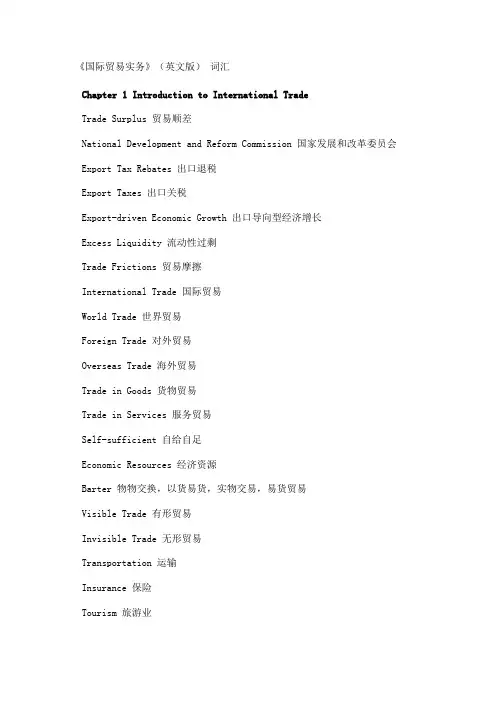
《国际贸易实务》(英文版)词汇Chapter 1 Introduction to International TradeTrade Surplus 贸易顺差National Development and Reform Commission 国家发展和改革委员会Export Tax Rebates 出口退税Export Taxes 出口关税Export-driven Economic Growth 出口导向型经济增长Excess Liquidity 流动性过剩Trade Frictions 贸易摩擦International Trade 国际贸易World Trade 世界贸易Foreign Trade 对外贸易Overseas Trade 海外贸易Trade in Goods 货物贸易Trade in Services 服务贸易Self-sufficient 自给自足Economic Resources 经济资源Barter 物物交换,以货易货,实物交易,易货贸易Visible Trade 有形贸易Invisible Trade 无形贸易Transportation 运输Insurance 保险Tourism 旅游业Balance of Trade 贸易差额A Favorable Balance of Trade 贸易顺差Trade Surplus 贸易顺差An Unfavorable Balance of Trade 贸易逆差Trade Deficit 贸易逆差Balance of Payments 国际收支平衡,国际收支差额A Favorable Balance of Payments 国际收支顺差An Unfavorable Balance of Payments 国际收支逆差International Monetary Fund(IMF)国际货币基金组织Foreign Direct Investment(FDI)对外直接投资,外商直接投资Portfolio Investment 间接投资Chapter 2 International Trade PolicyProtectionism 贸易保护主义Free Trade 自由贸易The National Interest 国家利益Doha Trade Talks 多哈贸易谈判Acquisitions 购并Trade Barriers 贸易壁垒Infant Industries 幼稚产业Tariffs 关税Subsidies 补贴Quantitative Restrictions 数量限制Encouragements 鼓励Import Tariff 进口关税Non-tariff Barriers(NTB)非关税壁垒Export Taxes 出口关税Export Subsidies 出口补贴Protective Tariffs 保护性关税Revenue Tariff 财政关税Specific Duties 从量税Ad Valorem Duties 从价税Compound Duties 复合税Harmonized Tariff Schedule of the United States(HTS)美国协调关税明细表Harmonized System 商品名称及编码协调制度International Harmonized Commodity Coding and Classification System 商品名称及编码协调制度World Customs Organization 世界海关组织Customs Tariff of Import/Export of the People’s Republic of China 中华人民共和国进出口关税条例Import Quota 进口配额Binding Quota 限制性配额Non-binding Quota不具约束力的配额Zero QuotaAbsolute Quotas 绝对配额Tariff-rate Quotas 关税配额Voluntary Export Restraint(VER)自动出口限制Multi-Fiber Arrangement 多种纤维协定Market Failures 市场失灵Domestic Content Requirements 国内成分要求Government Procurement Policies 政府采购政策Buy America Act of 1933 1933年购买美国货法案Red-tape Barriers进口环节壁垒Domestic Supply 国内供给Domestic Demand 国内需求Floor Price 最低限价Shortfall of Supply 供应短缺Export Enhancement Program(EEP)美国的出口促进计划Dairy Export Incentive Program(DEIP)奶制品出口激励项目Chapter 3 Trade Bloc and Trade BlockAsia-Pacific Economic Co-operation Organization (APEC)亚太经合组织Hanoi 河内(越南首都)Stalemate 僵局Open Regionalism 开放的区域主义Trade Liberalization 贸易自由化Most Favored Nation 最惠国Multilateralism 多边贸易Doha Round 多哈回合Free Trade Agreement of Asia and the Pacific(FTAAP)亚太自由贸易协定Free Trade Area 自由贸易区Preferential Trade Agreements(PTAs)特殊优惠贸易协议Bilateral Free Trade Agreements 双边自由贸易协定Discriminatory Tariffs 歧视性关税Tariff Rates 关税税率Trade Discrimination 贸易歧视Trade Bloc 贸易集团Trade Block 贸易禁运EU(European Union)欧盟(欧洲联盟)NAFTA(North American Free Trade Agreement)北美自由贸易协定,北美自由贸易区MERCOSUR(Mercado Comun del Cono Sur)南方共同市场SCCM(Southern Common Markets)南方共同市场ASEAN(Association of Southeast Asian Nations)东南亚国家联盟EFTA(European Free Trade Area)欧洲自由贸易区ASEAN Free Trade Area(AFTA)东盟自由贸易区Customs Union 关税同盟EEC(European Economic Community)欧洲经济共同体EC(the European Community)欧洲共同体Economic Union 经济同盟,经济联盟Trade Embargoes 贸易禁运Economic Sanctions 经济制裁United Nations 联合国Stamp Act 印花税法案Townshend Acts 汤森条例Trade Elasticity 贸易弹性Chapter 4 WTO:A Navigation GuideFranchises 特许经营World Trade Organization(WTO)世界贸易组织Uruguay Round 乌拉圭回合General Agreement on Tariffs and Trade(GATT)关税与贸易总协定Doha Development Agenda 多哈发展议程(多哈回合谈判)WTO Agreements 世界贸易组织协议The World Bank 世界银行International Monetary Fund(IMF)国际货币基金组织Appellate Body 上诉机构Dispute Settlement Panels 争端解决专门小组Plurilateral Committees 诸边协议委员会Ministerial Conference 部长会议The General Council 常务理事会The Dispute Settlement Body 争端解决机构The Trade Policy Review Body 贸易政策审议机构Goods Council 货物贸易理事会Services Council 服务贸易理事会TRIPS Council 与贸易有关的知识产权理事会The Textiles Monitoring Body 纺织品监督机构Heads of Delegations(HOD)代表团首脑The Secretariat 秘书处Sustainable Development 可持续发展Plurilateral Trade Agreement 诸边贸易协定Marrakesh Ministerial Meeting 马拉喀什部长会议(摩洛哥)TRIPS Agreement 与贸易有关的知识产权协定Trade-Related Aspects of Intellectual Property Rights(TRIPS)与贸易有关的知识产权Contracting Parties 缔约国Trade Without Discrimination 贸易无歧视Most-Favored-Nation Treatment 最惠国待遇National Treatment 国民待遇Transparency 透明度Access to Markets 市场准入Navigation Guide 导航General Agreement on Trade in Services(GATS)服务贸易总协定Trade-Related Investment Measures TRIMS 与贸易有关的投资措施Chapter 5 Terms of Commodity——QualityCommodity 商品、货物Manufactured Goods 工业制成品Name of Commodity 货物的品名Description of Goods 货物的名称,货物的描述Quality of Commodity 货物的品质Sample 样品Representative Sample 代表性样品Original Sample 原样Type Sample 标准样品Reference Sample 参考样品Duplicate Sample 复样Sale by Sell’s Sample 凭卖方样品买卖(销售)Sale by buyer’s Sample 凭买方样品买卖(销售)Return Sample 回样Counter Sample 对等样品Sealed Sample 封样The Parties to the Contract 合同的当事人Quality to be about equal to the Sample 品质与样品大致相同Specifications 规格Grade 等级Standard 标准Fair Average Quality(F.A.Q.)良好平均品质Good Merchantable Quality(G.M.Q.)上好可销品质Brand 品牌Trademark 商标Description,Drawing and Diagram 说明书,图纸和技术协议书等Quality Tolerance 品质公差Chapter 5 Terms of Commodity——QuantityQuantity of Commodity 货物的数量Unit of Measurement 计量单位The Metric System 公制The British System 英制The U.S. System 美制Numbers 个数Weight 重量Length 长度Area 面积Volume 体积Capacity 容积International Measurement Conference 国际测量会议International System of Units(SI)国际单位制Gross Weight 毛重Net Weight 净重Gross for net 以毛作净Conditioned Weight 公量Theoretical Weight 理论重量More of Less Clause 溢短装条款Chapter 5 Terms of Commodity——PackingPaking 包装Nude Cargo 裸装货Cargo in Bulk 散装货Outer Packing 外包装Baling 打包Hogsheads 美国橡木桶Inner Packing 内包装Pallet 托盘Shipping Mark 运输标志(唛头)Additional Mark 附属性标志Indicative Mark 指示性标志Warning Mark 警告性标志Neutral Packing 中性包装Neutral Packing with Designated Brand 定牌中性包装Neutral Packing without Designated Brand 无牌中性包装Chapter 6 International Trade TermsL/C Issuing Date 信用证的开证日期Partial Shipment 分批装运Transshipment 转运Shipment 装运Terms of Payment 支付条件Draft 汇票Liner 班轮Trade Terms,Price Terms,Delivery Terms 贸易术语,价格术语,交货术语Warsaw-Oxford Rules 1932 1932年华沙——牛津规则International Law Association 国际法律协会Revised American Foreign Trade Definitions 1941 1941年美国对外贸易定义修正本INCOTERMS 2000 2000年国际贸易术语解释通则International Chamber of Commerce(ICC)国际商会Carrier 承运人Frontier 边境Clear 清关Value added tax(VAT)增值税United Nations Commission on International Trade Law(UNCITRAL)联合国国际贸易法律委员会Ship’s Rail 船舷Quay 码头Multi-modal Transport 多式联运Trim 平舱Stow 理舱EXW 工厂交货FCA 货交承运人FOB 装运港船上交货FAS 货交船边CFR 成本加运费CIF 成本加保险费加运费CPT 运费付至CIP 运费、保险费付至DAF 边境交货DES 目的港船上交货DEQ 目的港码头交货DDU 未完税交货DDP 完税后交货。
11.1 The Concept of International Trade国际贸易的观念International trade is the exchange of goods and services produced in one country for those produced in another country. In mo st cases countries do not trade the actual the goods and services. Rather they use the income or money from the sale of their products to buy the products of another country.1.2 Introduction to International Payments and SettlementsInternational payments and settlements are financial activi ties conducted among different countries in which payments are effecte d or funds are transferred from one country to another in order to clear relations of debts.国际支付与结算是指为清偿国际间的债权债务关系或跨国转移资金而发生在不同国家之间的货币收付活动。
1.2 categories(分类)(1)、According to the cause of international settlement International trade settlement(国际贸易结算)International trade settlement is created on the basis of sa les of commodities.国际贸易结算是指有形贸易活动(即由商品的进出口)引起的货币收付活动.(主要形式)International non-trade settlement (国际非贸易结算)invisible trade无形交易financial transaction金融业务payment between governments政府间的款项others 其他业务(2)、According to whether cash is used Cash settlement(现金结算)International payments is effected by shipping precious metals taking the form of coins, bars or bullions to or from the trading countries. Non-cash settlement(非现金结算)International payment is settled by way of transferring funds through the accounts opened in these banks.Four major clearing systems in the world(四大清算系统)2.1 SWIFT(Society for Worldwide Interbank Financial Telecommunication )SWIFT is a service organization established to meet a number of specialized service needs relating to interbank financial communicatio ns through a dedicated data processing and telecommunication system. Membership 会员制Low expenses 低费用Security 安全性Standardised 标准化2.2 CHIPS(The Clearing House Interbank Payment System).纽约清算所同业支付系统 2.3 CHAPS(Clearing House Automated Payment System)伦敦银行同业自动支付系统 2.4 TATGET(Trans-European Automated Real-Time Gross-Settlement Express Transfer)泛欧实时全额自动清算系统3.1 Correspondent Bank代理银行Correspondent banking is an arrangement under which one bank ( correspondent) holds deposits owned by other banks (respondents) and p rovides payment and other services to those respondent banks. Such ar rangements may also be known as agency relationships in some domestic contexts.是接受其他国家或地区的银行委托,代办国际结算业务或提供其他服务,并建立相互代理业务关系的银行。
III. Explain the following terms1. shipment contractShipment contract is a contract using an Incoterm which indicates that the delivery happens at the time or before the time of shipment.2. symbolic deliverySymbolic delivery is a delivery situation in which when the seller delivers the buyer does not physically receive the goods. This kind of delivery is proved by the submission of transport document by the seller to the buyer.3. arrival contractArrival contract means a contract using an Incoterm which indicates that the delivery happens when the goods arrive at the destination.4. actual deliveryActual delivery refers to a delivery situation in which when the seller delivers the buyer does physically receive the goods.IV. Short questions1. Who pays for loading for shipment under FOB ?The seller.2. Who pays for unloading under CIF?The buyer.3. Compare and contrast FOB, CFR and CIF?Similarities: a. The seller's risk will be transferred to the buyer when the goods are loaded on board, b. The seller is responsible for export customs formalities while the buyer is responsible for import customs formalities, c. The buyer is responsible for unloading the goods at the port of destination, d. All three terms can only be used for waterway transportation.Differences: a. FOB requires the buyer to arrange and pay for the ocean transportation; CFR requires the seller to arrange and pay for the ocean transportation; CIF requires the seller to arrange and pay for the ocean transportation and insurance against the buyer's risk.4. What are the two types of trade terms concerning the transfer of risks?Shipment contract terms vs. arrival contract terms. Under shipment contract terms the seller's risk will be transferred to the buyer before the goods depart from the place/port of shipment. Under arrival contract terms the seller will bear the risk of the goods until the goods arrive at the destination.5. What are the differences and similarities between CPT and CFR?Major similarities: a. The seller should contract and pay for the major carriage. b. The seller is not taking the risk of loss of or damage to the goods during the transportation.Difference: a. CPT is applicable to any kind of transportation mode while CFR is only used for waterway transport, b. Under CPT the seller's risk will be transferred to the buyer when the goods are handed over to the first carrier nominated by the seller. Under CFR the seller's risk will be transferred when the goods are loaded on board the vessel.6. What are the differences and similarities between CIP and CIF?Major similarities: a. The seller should contract and pay for the major carriage. b. The seller is not taking the risk of loss of or damage to the goods during the transportation, c. The seller must obtain insurance against the buyer's risk.Difference: a. CPT is applicable to any kind of transportation mode while CFR is only used for seaway or inland waterway transport, b. Under CPT the seller's risk will be transferred to the buyer when the goods are handed over to the first carrier nominated by the seller. Under CFR the seller's risk will be transferred when the goods are loaded on board the vessel.7. If you trade with an American, is the sales contract subject to Incoterms without any doubt? What should youdo?No. The Revised American Foreign Trade Definitions 1941 is still in use, especially in the North American area. It has different interpretation about some trade terms. The traders should clarify the choice of rules before any further discussion.8. What are the most commonly used trade terms?FOB, CFR & CIF.9. Who is responsible for carrying out customs formalities for exports under an FOB contract?The seller. According to Incoterms 2010, except EXW and DDP these two terms, all the other eleven terms require the seller to handle the export customs formalities, while the buyer the import customs formalities.10. If a Chinese trader signs an FOB Hamburg contract, is he exporting or importing?Importing. FOB should be used with a "named port of shipment", if Hamburg is the port of shipment, from the Chinese trader's perspective, he is importing.V. Case studies1. An FOB contract stipulated "The shipment will be effected in March 2011." When the goods were ready on 10March 201 l, the seller contacted the buyer for shipment details. The buyer faxed "Please send the goods to the port for loading on 21 March. The vessel will depart on 22 March." The seller sent the goods to the port accordingly. However the nominated vessel did not turn up and the goods had to be stored in the warehouse at the port. On the night of 21 March a fire happened in the warehouse area and part of the goods was damaged.When the vessel arrived two days later the seller and the buyer had an argument about the settlement of the loss. The seller required the buyer to bear the loss caused by the fire, but the buyer believed that the vessel arrived within the shipment period and the loss occurred before the seller delivered the goods therefore the seller should bear the loss. Please provide your solution.析:1)首先案例中提到货物发生了损失是由于货物存放在码头仓库期间发生火灾造成的。
Chapter 1 Brief Introduction to International TradeⅠ.Fill in the blanks to complete each sentence.1. An international sales contract is not merely a document setting forth quanti ty, price, delivery arrangement of the product; it must also take into account the local legal system and political and exchange risks in the country involved.2. Settlement on commercial credit usually includes payment in advance, ope n account, remittance and collection.3. Settlements on bank credit include letter of credit and bank guarantee.4. Trade terms are also called price terms and delivery terms.5. While the EXW ( Ex Works) terms represents the minimum obligation for the seller, DDP represents the maximum obligationa.6. Payment in advance is most advantageous to the seller.7. Open account is least advantageous to the seller.8. Collection can be divided into documentary collection and clean collection. Ⅱ. Define the following terms.(略)Ⅲ.Translate the following terms or sentences into English.1.以银行信用为基础的结算:settlement on bank credit2.货币波动的可能性:the potential of the fluctuation of currency3.出口清关:clear the goods for export/export clearance)4.支付保费: pay the insurance premium5.办理出口手续: handle export formality6.国际贸易的主要参与者:major participants in international trade7.商品检验条款:commodity inspection clause8.履行交货责任:fulfill the obligation to deliver goods9.货物已越过船舷:the goods pass the ship’s rail10.国际贸易合同是在与国内贸易合同完全不同的环境下进行的。